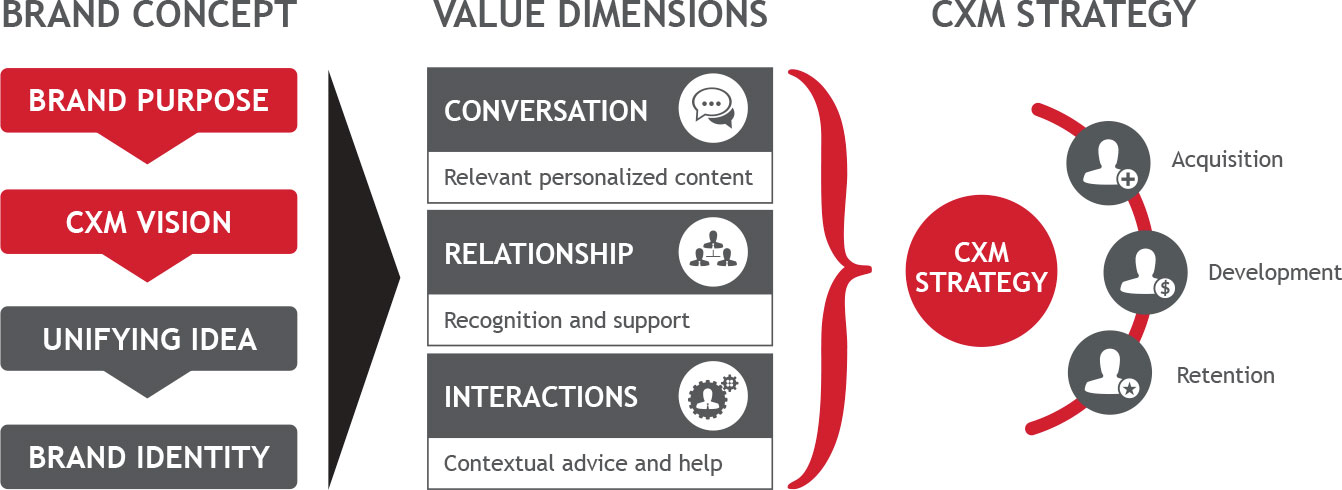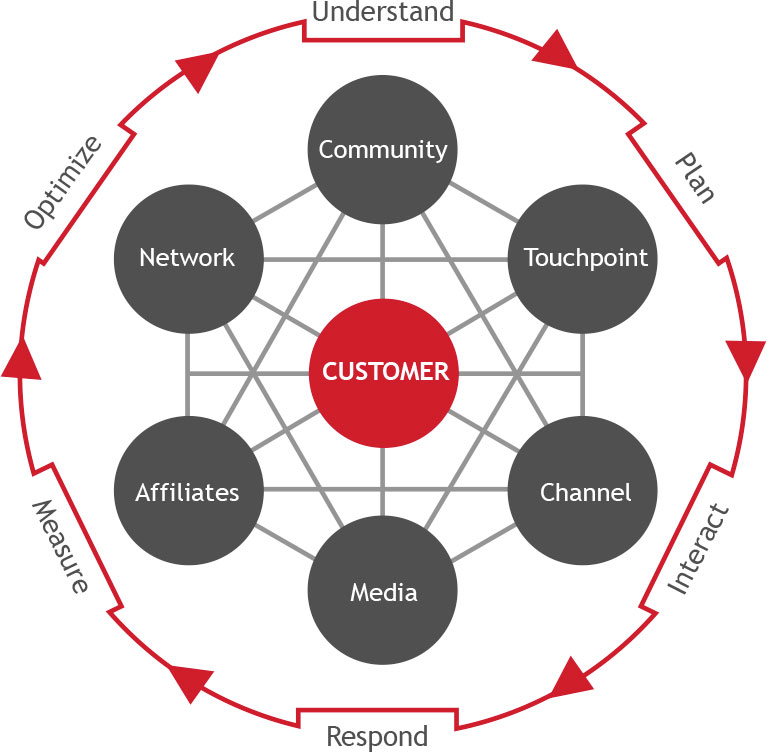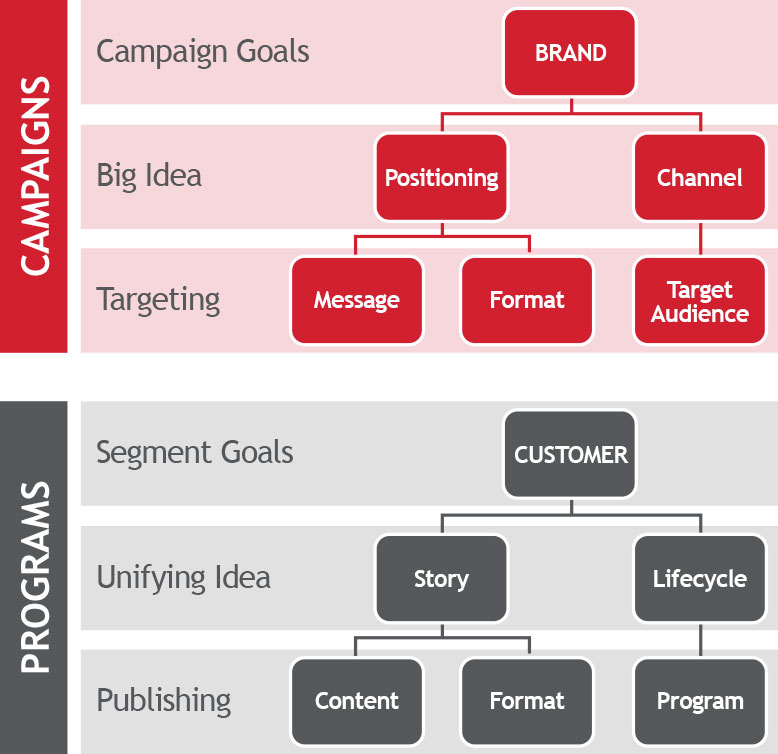The Connected Experience
Marketers have been slow to adapt to a post-campaign world where the old familiar rules of brand-building are obsolete. To connect with customers today marketers must not only manage channel complexity, they must make the brand more relevant and central to their lives.

In the late 1950s the Volkswagen Beetle was little more than a curiosity. At a time when most cars were garish symbols of consumerism, the Beetle was exactly the opposite: small, under-powered, strange looking, it had failed to gain much of a foothold on this side of the Atlantic, despite its popularity in Europe.
That all changed in 1960 with the launch of a national ad campaign which turned traditional automotive advertising upside down. It still ranks as perhaps the greatest ad campaign of all time. Instead of bragging about the Beetle, the ads poked fun at its perceived deficiencies (“Lemon”, mocked one headline, “Think Small”, suggested another), before explaining they were in fact virtues. The intent was to charm as much as inform and that approach strongly appealed to an emerging counter-culture longing to break free from the conformity of that post-war period.
Thanks to that campaign, VW sales took off, and the Beetle soon became a familiar sight on the roads, riding an anti-establishment wave which swept across society in the sixties. Meanwhile the advertising business was changed forever: ad copy stopped sounding like a showroom salesman. Instead it strived to give the brand a distinct personality, maybe not as quirky as the VW Beetle, but something people could relate to.
Today of course that campaign would be executed very differently. In the 1960s print was the default medium. Now digital media is the preferred channel. And that fact alone invites the question: would the VW campaign have won the same level of fame in this current fragmented media environment? One thing is sure: a different approach would be needed to have the same market impact.
We have entered a post-campaign world where people interact with each other through social sharing, indifferent to most forms of advertising. Ad campaigns rarely become a topic of discussion anymore (except at Super Bowl time). Which is why the concept of a campaign has become obsolete. The word itself should be retired. Even so many marketers today still view their top challenge as developing innovative campaigns that garner attention. The real lesson marketers should draw from that ground-breaking VW campaign: to truly connect with customers, a brand must mirror their beliefs.

Formula for Success
When VW first landed here from Germany in 1949 it was very much a startup brand (it sold just two cars that year). But a startup brand today would never dream of throwing money at a large advertising campaign (a mistake that drove many first-generation dotcom companies out of business). Instead they methodically build a fan base through word of mouth. A celebrated example is the Dollar Shave Club, acquired last year by Gillette for the generous sum of $1 billion. This was a 5-year old company which bought razors from South Korea and sold them directly to men at a fraction of the retail cost. Beyond a recurring revenue stream, what did Dollar Shave Club offer that Unilever wanted so badly? A loyal tribe of 3 million online buyers. Plus, a whimsical brand made popular through social media and comedic videos posted on YouTube. The witty content (like “Bathroom Minutes” magazine) kept members engaged. The brand offered its subscribers more than transaction ease and convenience: it served as a brotherhood for frugal shavers.
Another example of a startup brand profiting from word-of-mouth is the mattress-maker Casper which has enjoyed hockey-stick growth by transforming the bed-buying process in a staid industry crying out for disruption. Instead of enduring multiple store visits to test different mattresses, customers are offered a direct-delivery 100-day free trial period accompanied by an Amazon-like guarantee. Early buyers were so infatuated with the accordion-style “unboxing” of the form-fitting bed that they began to post videos of the experience online which helped make Casper an overnight sensation.

Casper views itself as more than simply a mattress-maker offering an exceptionally comfortable product: it is in the vanguard of a growing lifestyle movement popularizing the health benefits of proper sleep. That personal connection with customers may help to insulate it from expected counterattacks by its much larger storefront competitors (Tempur Sealy is already fighting back with its own knock-off version of the no-risk direct-delivery model).
The formula for success in a post-campaign, ad-free, self-serve world is making an emotional connection with customers – and then staying connected through experiences that keep the romance alive. Certain brands do that naturally – think LEGO, SoulCycle, Patagonia, Red Bull, UnderArmour, Etsy – all of which have a relatable identity. Their customers are more than simply fans or followers – they are active participants in the brand, contributing to the conversation through their network of social connections.
Sharing the worldview of customers can elevate a brand to a higher plane of trust.
Flipping the switch from an ad-centric messaging model to one based on relationship-building requires a complete mind shift. To create more rewarding brand experiences – distinctive experiences customers want to talk about and share – marketers must lead with empathy. Sharing the worldview of customers can elevate a brand to a higher plane of trust and win over an army of enthusiasts. As Jorgen Vig Knudstorp, cochairman of the LEGO Brand Group, says, “If you can make your brand a value – a part of their identity – you have a really powerful competitive advantage”.

Vive la révolution
Just about every CMO today realizes that marketing in the Age of the Customer is about delivering a great brand experience. Unfortunately, most have their feet locked in cement. Often, they oversee hidebound product marketing cultures frozen in time. For marketing fundamentalists, unwilling to give up brand messaging, the notion of “customer-first thinking” is more about perception than reformation – merely a tagline that sticks a “smiley face” on the brand. Bolder thinkers, willing to battle the status quo, face a booby-trapped obstacle course: stove piped systems, IT intransigence, departmental siloes, operational handcuffs, growth fixation, executive myopia, cultural apathy, the list goes on. It is easy to see why a well-meaning CMO might concede defeat even before starting down the path of transformation, knowing what lies ahead.
However, there is no turning back to the glory years of the “Mad Men” era when ad campaigns ruled the air waves, soaking up most of the marketing budget. That playbook has been smashed to pieces by the always-on expectations of customers; by the growing hegemony of the big platform services (like Amazon, Netflix, Snapchat, Instagram and Facebook); by online marketplaces which are disrupting and even displacing conventional supply chains (Uber, Airbnb); and by the feverish pace of technological change (consider the surge of interest in chatboxes, voice-based search and virtual assistants).
Being “bigger” and “best” is no longer enough: those claims win satisfaction, not affection. According to a recent consumer study, most people could care less if three-quarters of the brands they use disappeared forever. That is a severe indictment of the entire marketing business as it exists today.
Being “bigger” and “best” is no longer enough: those claims win satisfaction, not affection.
Marketers are strangers in a strange land, uncertain which direction to head. With no familiar landmarks in sight, any “shiny object” can seem like a good way to go, no matter what the odds of success.
Forrester Research argues that in the face of this turmoil marketing must take the lead in envisioning a more enlightened future: “CMOs must reimagine how their customers are exposed to and experience their brand across all touchpoints. They must lead the charge across their organization to create a connected experience that will delight customers wherever they interact with the brand.”
As society adjusts to a more connected world – powered by conversational interfaces, universal connectivity of smart devices, open collaborative communities, AI-driven interactions, and much more – marketers must shout from the corporate rooftop: “Vive la révolution”. They can turn the page on history by adopting a more humanistic marketing model which finally drives a stake into the heart of the old one.
The test of character for the leaders of a business is not the decision to march down the path of transformation: it is having the courage to resist incrementalism.
To make that leap, marketers must figure out how to make the brand more relevant and central to the lives of customers. As a starting point, they need to understand the values, principles, and aspirations of the customers they choose to serve, and then craft their story around that belief system. In doing so, they will have a clearer idea of how to make customers feel “I can’t imagine life without you”.
Resisting Incrementalism
Creating a connected experience involves much more than easy navigation of touchpoints or consistent interactions across all communication channels. It should lead to:
- More Informed Conversations: People live their lives through their screens, sharing their experiences with everyone they know, no matter how trivial or mundane. Companies need to think creatively about how they join that conversation. There is only one way to break through the content glut that passes for conversation today: personalizing the communication stream so that it simulates as much as possible a real dialogue between friends, where ideas and opinions are freely discussed, while remembering and building upon past exchanges of information.
- More Rewarding Relationships: Today a brand must make it as easy and rewarding as possible for people to continue buying – and to welcome and facilitate frank feedback about their experience. As customers interact across multiple channels, the two-way flow of communications should be governed by tiered permission levels which control the level of intimacy; by explicit preferences that guide the creation and delivery of content; and by knowledge of shared beliefs and values which form the bedrock of an ongoing relationship.
- More Valuable Interactions: Companies must serve customers in real-time – not days later, but seconds later, when they most need the help they’re seeking. Knowing the full context of a question at a moment in time – factoring in the intent, location, and urgency of the request – should trigger a personalized notification, subject to consent. That consent is far more likely to be granted if the brand is a go-to authority within a specific subject area.


For most businesses, the magnitude of complexity required to design and orchestrate a connected experience is daunting. The way marketers are organized, think, plan and act must be completely revamped. The walls that separate marketing, sales and service must be torn down. Annual planning models, with their inflexible budgets and top-down goal-setting, must be streamlined. More flexible workflow design must be adopted to promote collaboration. And certainly, a business will never gain alignment if people are not encouraged and incentivized to think differently.
The test of character for the leaders of a business is not the decision to march down the path of transformation: it is having the courage to resist incrementalism. A cautious one-step-at-a-time pace will only put a business further behind. Agility must be weaved into the operating philosophy and decision style. And that means speeding up the metabolism of marketing: abandoning lengthy campaign-development cycles in favor of more adaptive methods, with the flexibility to act immediately on opportunities that surface through trend-spotting.
Shock and Awe
There are many competing schools of thought on what the new marketing model should look like. While everyone acknowledges that the marketing funnel has been flipped, with customers in control of what they see and hear, no one is quite sure what to do about it. “Go social – go mobile – go local” has become an oft-heard refrain. But that simplistic answer fails to address the crux of the problem. Just adding more channels to the marketing mix will not get customers to lower the conversational drawbridge. In fact, it just might force them to dig a bigger moat.
What goes on today could still be characterized as “shock and awe” campaigning. By using marketing automation in combination with programmatic media buying, marketers can devise highly-complex multi-channel demand generation campaigns, with many different reinforcing loops, driving target audiences toward a promotional snare. None of that interaction planning does much to engender more human connections with people. Which is why marketers need to stop thinking about campaigning and make it in the interest of customers to have a real conversation.
The goal is not simply to stay connected: it is to be viewed as indispensable
The hardest part of conversing with strangers is finding something in common to talk about. To sustain a conversation past that first greeting, you must find the common ground: a subject that interests the other person as much as you. Instead of starting out with what a brand wants to say about itself, the strategic planning process should begin with what the customer needs to know.
A customer journey map paints that picture: describing the goals, intentions, feelings and pain points as a customer progresses from one stage of the buying cycle to another. Once a purchase is made, a lifecycle map shows how the brand can support the full relationship arc, from onboarding to regular engagement to energizing the fan base.
Instead of pushing out point-in-time campaign offers, under the guise of branded content, marketers should construct a medley of relationship-building programs designed to move customers along the loyalty continuum. The goal is not simply to stay connected: it is to be viewed as indispensable, where the relationship transcends commerce.
The effort to cultivate that relationship – to learn what matters to customers, create continuous value, talk about the things that matter, earn goodwill – is an investment in the longevity of the brand. One that is far more likely to pay off than pumping up the ad volume when no one is listening any more.
The old marketing model is broken – that much is certain. What ultimately replaces it may still be up for debate. But what is not debatable is that customers will only truly be interested in making a continuous connection with a brand if they can identify with it.

Stephen Shaw is the chief strategy officer of Kenna, a marketing solutions provider specializing in customer experience management. He is also the host of a regular podcast called Customer First Thinking. Stephen can be reached via e-mail at sshaw@kenna.ca